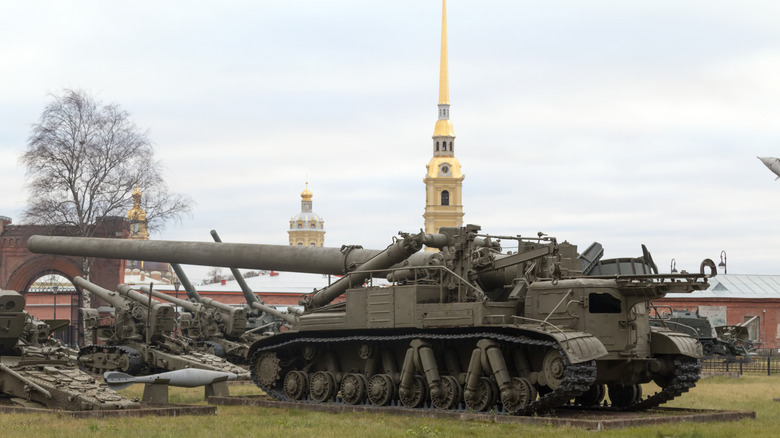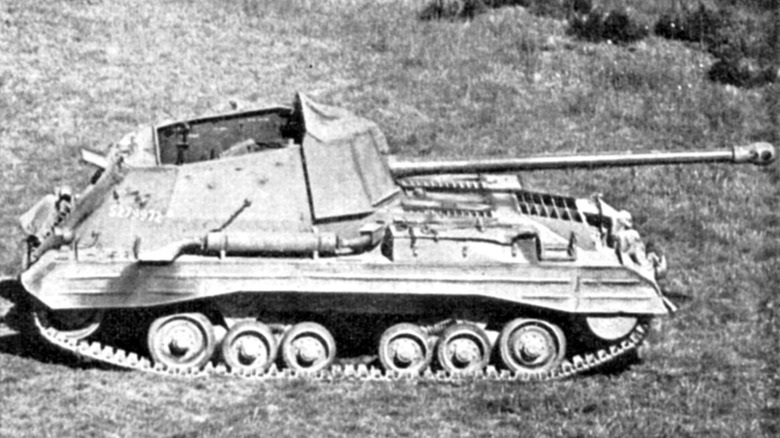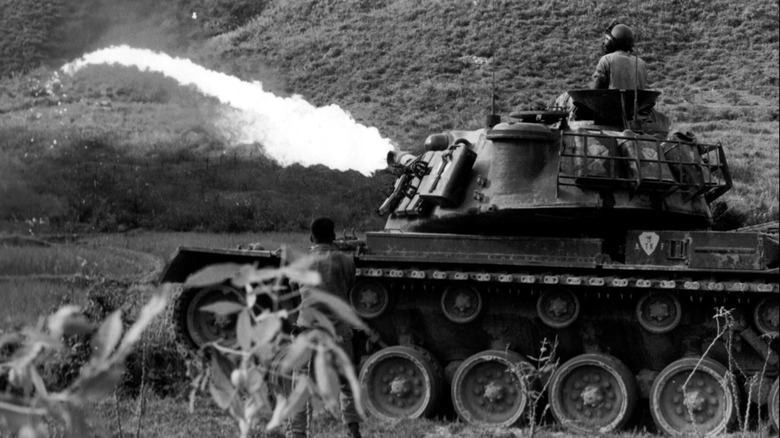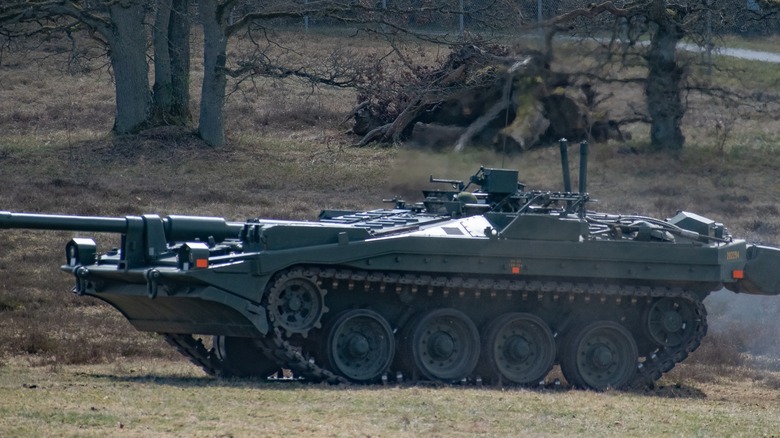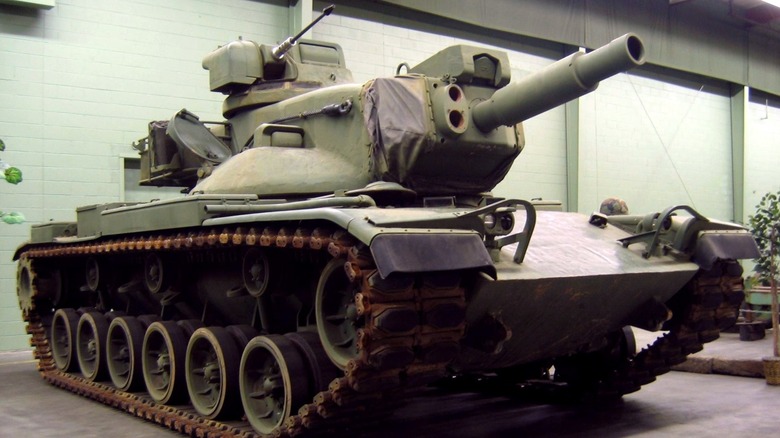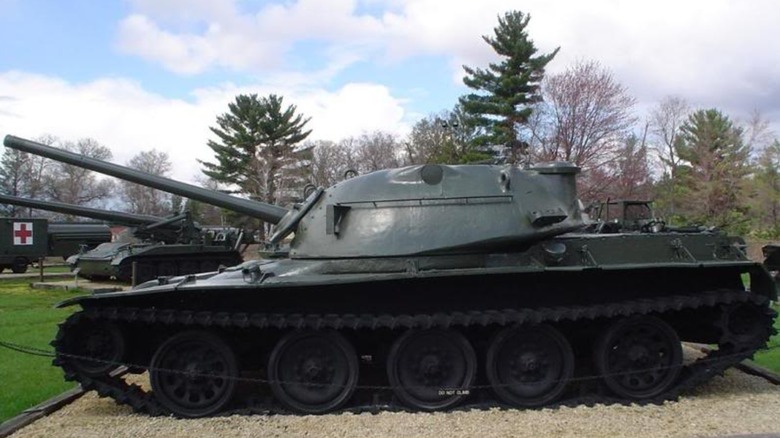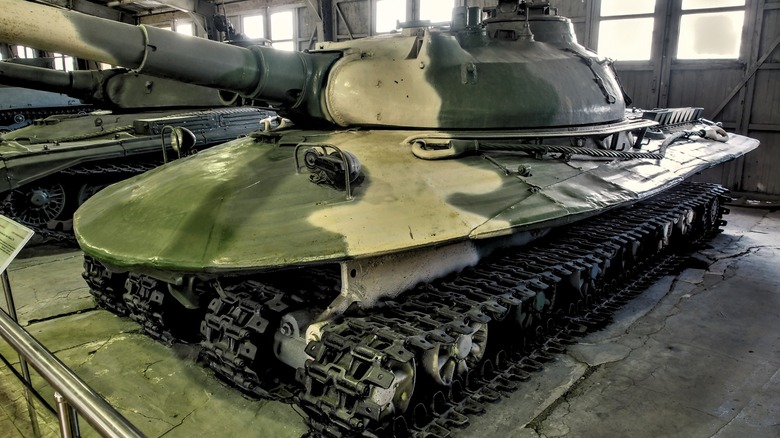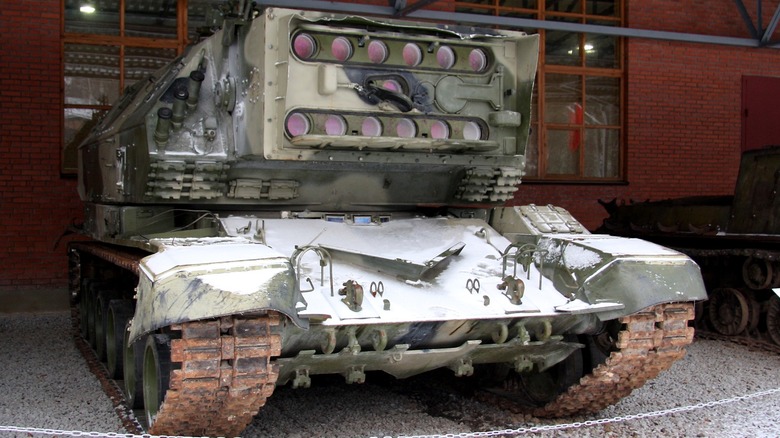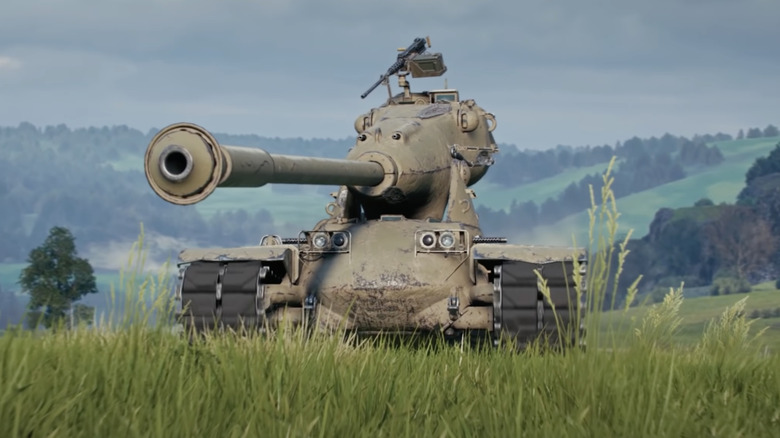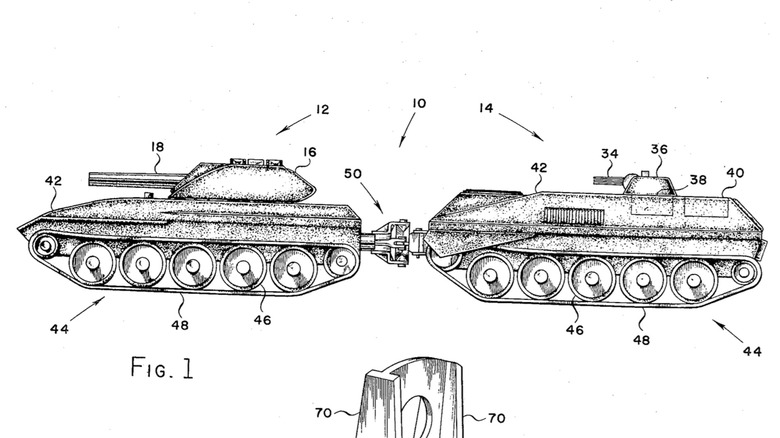10 Of The Most Interesting Military Tanks Of The Cold War
Tanks have played an important role on the battlefield ever since they were invented to cross No Man's Land in World War 1. Designs have run the gamut from iconic and impressive to weird beyond measure, and while tanks helped shape the course of World War 2, nuclear weapons changed the face of warfare. What need would countries have for tanks if they could just atomize their enemies? Plenty, as it turns out.
From 1947 to 1991, the United States and the Soviet Union were embroiled in a period of spying and attempts to destabilize each other through proxy wars — armed conflicts where they supported opposing sides — without physically engaging in battles against one another. During this time, everyone thought an actual war was just around the corner, and while nuclear bombs were powerful, they were hard to develop and even harder to deploy. So, countries did what they could to prepare.
Some nations invented new technologies, which produced the first satellites among other things, but many engineers tried to improve existing technologies, including tanks. Some of these ideas, such as novel designs for tanks that could hide more easily, came to fruition. Other concepts, including tanks designed to withstand nuclear blasts, never made it to production. Here are 10 fascinating tanks that epitomized the school of thought reigning during the Cold War.
Archer Tank
The arsenals of many armies tend to strike a balance between unbelievably high-tech weapons and workhorses guided by the philosophy, "if it ain't broke, don't fix it." Plenty of weapons designed for one conflict maintain relevance for several decades, despite their unusual appearances.
The SP 17pdr, Valentine, Mk I, Archer, or just the Archer for short, was originally designed for World War 2. Equipped with an Ordnance QF 17 Pounder, this tank was created specifically to destroy enemy tanks, but to save money, instead of developing a new chassis around the weapon, British military brass decided to just slap it onto the Valentine infantry tank. It was cheap and reliable, but it was also low to the ground, which caused problems transporting the QF 17 Pounder. At least until engineers produced an unorthodox solution.
Instead of elevating the cannon slightly, military engineers intentionally installed the Archer's QF 17 Pounder pointing backward. This made the tank perfect for executing hit-and-run attacks where it fired and ran away; it didn't need to turn around to retreat. While the Archer saw plenty of use during World War 2, the British Army kept a few in reserve during the Cold War and sold several to the Egyptian Army. These hand-me-down Archers saw use during the 1956 Suez Canal crisis, but after that, the Archer line faded into obscurity.
Flamethrower Tank M67 Zippo
Many people know how a flamethrower works. The weapon is a terrifying sight to behold, even though it has a limited number of uses and an even more limited range. And the only thing more terrifying than a flamethrower is a tank equipped with one.
During World War 2, U.S. soldiers witnessed how flamethrowers could effectively deal with entrenched enemies – even more so if the flamethrower was attached to a tank. At the time, the U.S. Army only had vehicles like the M3A1 Satan, an otherwise redundant tank retrofitted with a flamethrower. After World War 2 ended, the Army continued expanding on the idea of a proper flamethrower tank, especially when the Korean War started. The Flamethrower Tank M67 Zippo was the final result of this push for heavily armored and mobile flamethrowers.
As you might expect, the flamethrower component of the M67 tank took up the entire turret, but engineers designed it to look like a standard 90mm T54 gun — possibly to prevent enemies from properly identifying the tank and its armament. While the M67 was originally supposed to participate in the Korean War, engineers continued developing the tank until it was ready for combat. Despite incomplete combat records, it is believed that the M67 saw action during the Vietnam War alongside the Self-Propelled Flamethrower M132, also nicknamed "Zippo." Unlike the M67, however, the M132 was an Armored Personnel Carrier, not a tank.
Stridsvagn 103
Due to pop culture, many people believe several misconceptions about tanks — they're neither slow, nor impervious. However, you might notice that "stealthy" isn't on the list of misconceptions. That's because tanks actually can sneak up on targets, with the right design.
The Stridsvagn 103 (literally "Combat Wagon 103" in Swedish) was a unique take on the standard tank design. The vehicle's most noteworthy feature was, ironically, its lack of a tank's most distinctive feature: the turret. The cannon was fixed in position and always faced forward, which meant that in order to shoot anything, crews had to turn the entire tank around and manually pitch the tank up and down with its suspension.
Contrary to what you might think, this turretless design proved fairly advantageous — hypothetically, anyway. The lack of the turret provided the Stridsvagn 103 a low profile, which gave it the advantage of stealth that few other tanks possessed. Plus, remember when we said tanks aren't actually slow? The Stridsvagn helped pioneer the concept of a speedy tank, as it was the first to utilize a turbine engine while others still relied on diesel piston engines. Combined with a "clutch and brake maneuver," the Stridsvagn could swing around on a dime while traveling at high speeds, guaranteeing it could menace invaders no matter where they were on the battlefield. However, the tank never saw any wartime action, so its true capabilities were never put to the test.
152mm Gun/Launcher M60A2 Starship
As previously stated, the most iconic feature of the tank is its big honking turret. These mobile cannons evolved alongside the overall design of tanks, but most never developed past the ability to fire different kinds of rounds faster. The key word being "most."
In the 1970s, the United State military introduced the M60A2, unofficially known as the Starship. From the turret ring down, the M60A2 was your standard M60 Patton hull. But from the ring up, it was a completely different beast. The "A2" part of the M60A2 came from its unique 152mm Gun/Launcher system. Unlike most tanks, the M60A2 Starship could fire both conventional tank rounds (including High-Explosive and High-Explosive Anti-Tank rounds) and anti-tank guided missiles.
The unique gun/launcher system made the M60A2 the most advanced tank at the time, but that wasn't the blessing it sounds like. The A2 system ended up backfiring both figuratively and literally. The tank needed constant maintenance since consistent use of the gun dislodged the missile fire control system, and when a missile was fired, the system often didn't close fully, exposing tank crews to the armament's noxious backdraft. And that's assuming the missiles fired at all, as they suffered from widespread propellant and tracking system problems. Just goes to show you that in the world of tanks, being unique isn't as important as being functional.
T95 Medium Tank
The M1 Abrams is considered one of the best tanks to ever roll across a battlefield. It's fast and durable, and it boasts near-unerring accuracy thanks to its laser rangefinder. However, this aiming technology didn't spawn fully formed from the ether; another tank's fire-control system had to stumble so the M1 Abrams' rangefinder could run.
The T95 was a prototype medium tank developed between 1955 and 1959. The vehicle's design implemented numerous components and features new to U.S. tanks, including composite armor and a smoothbore gun (a barrel without built-in helical grooves designed to make ammo spin). However, the T95's most historically important feature was its optical tracking, acquisition and ranging (OPTAR) fire control system. Unlike other rangefinders of the time, the OPTAR shot out pulses of light. However, these beams tended to scatter and provide "incoherent" results, so tank crews had to eyeball which ones were correct. Also, the OPTAR system stuck out of the sides of turrets like a big metal pimple, which made them obvious targets.
While the U.S. Army tested T95 tanks with multiple load-outs, including different turrets and engines, the tank always underperformed. Even the OPTAR was quickly abandoned. But, the Army revisited the idea after the invention of lasers. Today, lasers are the go-to rangefinder system solution.
Chrysler TV-8
Many automobile companies have participated in wartime efforts. During World War 2, Chrysler built tanks, planes, and other military vehicles. The manufacturer's engineers went on to create turbine engine-powered cars using what they learned from these battlefield contributions. And it kept building tanks after the war, too.
In the early 1950s, Chrysler began work on what would become known as the Chrysler TV-8, or just the TV-8. While many tanks rely on their turrets, the TV-8 took that component to the next level, as the vehicle was at least 60% turret. The tank's entire crew, ammunition stores, and even its engine could fit inside the turret. Also, the component looked like an elongated egg. Or a UFO; either comparison works.
Chrysler built the tank, hence the "Chrysler" part of its name, but where did the "TV-8" portion come from? Unlike all other tanks, navigation would have relied solely on a series of closed-circuit televisions. This unorthodox design was intended to seal the turret and make the vehicle amphibious, as well as shield tank crew eyes in the event of an atomic explosion. Unfortunately, the Chrysler TV-8 never made it to production, as the Army's top brass didn't believe that the tank's advantages justified what would have been extreme manufacturing changes and expenses. The closest the tank ever got to existing outside of a blueprint was a full-scale wooden mock-up.
Object 279
After World War 2, everyone feared the power of the atom, and different countries voiced these fears in different ways. Japan, for instance, created a movie that served as a commentary of these fears. Perhaps you've heard of it: "Godzilla." Russia, meanwhile, tried to construct a tank that could withstand a nuclear blast.
In many ways, Object 279 is the opposite side of the coin that spawned the Chrysler TV-8. This Soviet counterpart was an experimental heavy tank that boasted extra armor and four tracks instead of the standard two. However, the tank personifies vehicle design in a post-nuclear society thanks to its vaguely UFO-shaped exterior. While nuclear blasts are so powerful that even the shockwaves can decimate everything for miles around, the shell was designed to be more aerodynamic and thus more likely to weather these shockwaves right side up.
Like the Chrysler TV-8, development of Object 279 began in the early 1950s, but unlike the United States' tank, Object 279 made it to the prototype phase. However, that is where the tank began to run into problems. Perhaps the biggest issue was the four-track system. The treads were difficult to repair, thanks in no small part to the hollow connector beams that also served as fuel tanks. Moreover, the treads had difficulty traversing swampy and loose terrain. Ultimately, Object 279 was abandoned for more conventional and reliable tank designs.
1K17 Szhatie
The U.S. Navy uses lasers to shoot down drones, but despite what you might think, these are not a recent development, nor are they the sci-fi weapons you've no doubt seen in movies. Nations have actually been experimenting with laser weapons for decades.
The 1K17 Szhatie, also known as the "Stiletto" in NATO reports, was a top-secret "tank" designed for anti-missile defense. The vehicle's main chassis consisted of the hull of a 2S19 Msta-S, a self-propelled howitzer. In place of the vehicle's main weapon (the actual howitzer) engineers placed a special laser that used artificially grown rubies as a focusing medium. While the laser was intended to disable missiles, it was just as capable of knocking out cameras and computer systems. And while it couldn't punch through metal like a fictional laser, the 1K17 could warp metals. And of course, the laser blinded anyone who looked directly at it.
In the early 1990s, the Soviet Union built a working prototype of the 1K17 Szhatie, and the tank was later greenlit for full-scale manufacturing and use. But that never happened.Why, you may ask. In 1991, the Soviet Union fully collapsed and took the 1K17 Szhatie with it. A good thing, too, because it would have violated the Geneva Convention's "Protocol on Blinding Laser Weapons," which was later introduced in 1995.
M-V-Yoh
Throughout this article, we have mostly stuck to tanks that were actually produced in one form or another. Some were built in fairly large numbers, while others were restricted to a few prototypes or just a full-scale model. Then something like the M-V-Yoh, which was too ambitious for its own good.
Designed by the H.L. Yoh Company (originally Duncan Tool Design), which had a history of providing technical assistance on numerous projects for companies like Boeing and NASA, the M-V-Yoh was intended to demonstrate several of the company's tank-based technologies. These included a narrow oscillating turret (a turret that changes its barrel elevation by hinging the entire turret instead of just the barrel), a "track within a track" design that was narrower than traditional tank tracks, and a proprietary "ammunition grabber" that would help load tank rounds. The company also proposed features like a mantlet (armor where the barrel extends out of the turret) that would have protected crew against "nuclear, biological, and chemical threats," and two variations on a tank's autoloader, all of which weren't added to the final M-V-Yoh design.
Despite its novel tech, the M-V-Yoh was ultimately rejected because it wasn't a significant improvement over the M48 Patton. In fact, some of the proposed design elements might have constituted functional steps backward. For instance, the oscillating turret might not have provided enough protection in case of a nuclear attack, which is ironic because of H.L. Yoh's aforementioned mantlet design. All that came of the M-V-Yoh was a small-scale model and a playable tank in the game "World of Tanks," which is where the image above comes from (and one of the only places to find usable images of the tank on the internet!).
Lockheed/Forsyth Tank
Tanks, like so many other vehicles, are designed to be self-contained. Everything the crew needs is housed within the tank — or in the outside pouches, depending on the make and model. If a vehicle tows something along, that's usually considered an add-on. Some of the few exceptions are trains and the Lockheed/Forsyth Tank.
The Lockheed/Forsyth Tank was the brainchild of the brothers John and Robert Forsyth, who worked at the Lockheed Aircraft Corporation's Vehicle Systems Development Division. In 1962, the Forsyth brothers submitted their tank to a U.S. Armor Association design competition. Despite the Forsyth brothers not having any experience with tanks (they had previously developed amphibious vehicles, buses, and traction machines), their concept won First Place.
Looking at the patent filing pictured above, the Lockheed/Forsyth Tank seems to be towing an armored personnel carrier via an articulated joint, but the design is actually one long vehicle. Each section even contained its own power plant and could pull or push the other section in the event of an engine failure. However, the novelty of the Forsyth brothers' vision didn't end there. They also designed an armor system divided into layers, with two sheets of metal separated by a cavity filled with a combination of armored panels and foam filler. While the Lockheed/Forsythe Tank impressed military personnel, it relied on unproven technologies. Ultimately, the Army went with the more conventional XM551, which turned into one of the best U.S. tanks ever built, the M551 Sheridan.
